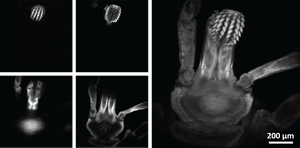Mar 22 2019
An innovative microscope has been developed by scientists for imaging massive groups of interacting cells in their natural surroundings.
 The researchers used the new microscope to image a tick. On the left are images from various depths, which were reconstructed into the volume image on the right. (Image credit: Amaury Badon, Boston University)
The researchers used the new microscope to image a tick. On the left are images from various depths, which were reconstructed into the volume image on the right. (Image credit: Amaury Badon, Boston University)
The microscope serves as a novel tool, allowing researchers to image neurons in living animals. It could also offer them an unparalleled view of how huge neutral networks communicate during different behaviors.
In the study published in Optica, The Optical Society’s journal for high-impact research, scientists from Boston University, USA, have demonstrated that their novel “multi-z” confocal microscopy system is capable of imaging the brains of living mice with a field of view bigger than a millimeter and at video speed.
To image huge groups of cells, subcellular or cellular details have to be captured at rapid speeds across a big 3D volume. This is very difficult because a majority of imaging techniques is known to have inherent tradeoffs between resolution, the field of view, and speed.
We found a way to merge the needed imaging features in a microscopy system that is easy to build and operate. It also provides results in real time without the need for complicated data analysis or image processing.
Amaury Badon, Study First Author, Department of Biomedical Engineering, Boston University.
Acquiring 3D image volumes
The novel “multi-z” microscope is predicated on confocal microscopy, a method often utilized for imaging cells. Confocal microscopy creates images with contrast and high resolution by utilizing a physical pinhole to let in-focus light through and block out-of-focus light. Conversely, it takes a considerable amount of time to scan a sample to obtain a sufficient number of 2D images to rebuild a 3D volume, and added to this, large amounts of data are also generated.
Therefore, to obtain multiple planes at the same time, the team came up with a new technique in which the light used for imaging cells in a single plane is also used for imaging cells deeper in the sample.
The researchers applied a method known as extended illumination, in which the objective lens of the microscope is just partly filled with the illuminating light, enabling the light to reach more deeply into the sample. Subsequently, the full objective lens is utilized for detecting fluorescence, which offers high resolution. The latest microscope—instead of having a single pinhole similar to conventional confocal setups—has an array of reflective pinholes, with each capturing in-focus light from the sample’s different depth.
Our method benefits from the contrast of confocal microscopy while being able to extend to volumetric imaging without sacrificing speed. Although extended illumination and reflective pinholes have been used before, this is the first time they were combined in a confocal microscope setup in a light-efficient way.
Amaury Badon, Study First Author, Department of Biomedical Engineering, Boston University.
Furthermore, the scientists customized the microscope for imaging at a larger scale when compared to traditional confocal microscopes and engineered it to image at video speed. It is vital to have fast image acquisition, because the fluorescence indicators monitoring the function of cells usually run on a few tens of milliseconds time scales.
Imaging neural activity in live animals
To demonstrate the new multi-z confocal microscopy system, the scientists used this instrument for imaging whole C. elegans worms, which are very large (measuring 500 to 800 µm) to effortlessly image simultaneously with a conventional confocal microscope. They were able to detect and track the activity of 42 neurons in the entire worm at the same time, even when the creatures were moving.
The scientists subsequently applied their microscope for imaging a mouse brain’s hippocampal region; during the imaging process, the animal was kept awake, making sure that its head was immobile. The researchers then successfully imaged the activity of neurons within a volume measuring 1200 X 1200 X 100 µm at video speed. They finally used an algorithm to detect as much as 926 neurons in the imaged volume.
Currently, the team is working to enhance the method’s speed and depth penetration and to make the microscope user-friendly and versatile as much as possible.